线程
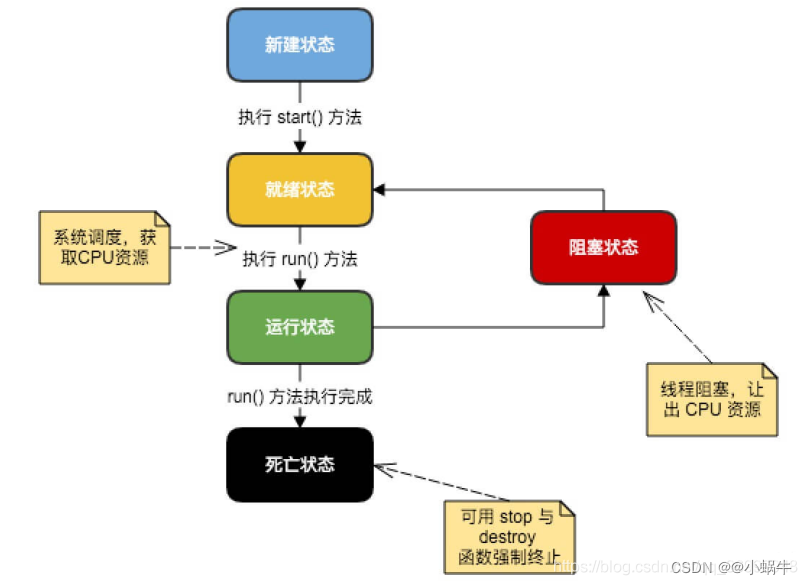
新建状态:
使用 new 关键字和 Thread 类或其子类建立一个线程对象后,该线程对象就处于新建状态。它保持这个状态直到程序 start() 这个线程。
就绪状态:
当线程对象调用了start()方法之后,该线程就进入就绪状态。就绪状态的线程处于就绪队列中,要等待JVM里线程调度器的调度。
运行状态:
如果就绪状态的线程获取 CPU 资源,就可以执行 run(),此时线程便处于运行状态。处于运行状态的线程最为复杂,它可以变为阻塞状态、就绪状态和死亡状态。
Thread
Runnable
Callable && Future
Callable产生结果,Future获取结果。
使用步骤如下:
创建 Callable 接口的实现类,并实现 call() 方法,该 call() 方法将作为线程执行体,并且有返回值;
创建 Callable 实现类的实例,使用 FutureTask 类来包装 Callable 对象,该 FutureTask
对象封装了该 Callable 对象的 call() 方法的返回值;
使用 FutureTask 对象作为 Thread 对象的 target 创建并启动新线程;
调用 FutureTask 对象的 get() 方法来获得子线程执行结束后的返回值。
package com.company;
import java.util.concurrent.Callable;
import java.util.concurrent.FutureTask;
import java.util.*;
public class Task {
public static void main(String[] args) throws Exception{
Scanner input =new Scanner(System.in);
int num=input.nextInt();
Function f=new Function();
f.runThread(num);
}
}
class Function {
public void runThread(int num) {
// 在这里开启线程 获取线程执行的结果
ThreadCallable tc=new ThreadCallable();
tc.number=num;
FutureTask<Integer> ft=new FutureTask<Integer>(tc);
new Thread(ft).start();
try{
System.out.print("线程的返回值为:"+ft.get());
}catch(Exception e){
e.printStackTrace();
}
}
}
/* 在这里实现Callable接口及方法 */
class ThreadCallable implements Callable{
public int number;
public Integer call()throws Exception{
int an;
double a=(1+Math.sqrt(5))/2;
double b=(1-Math.sqrt(5))/2;
double c=1/(Math.sqrt(5));
an=(int)(c*(Math.pow(a,number)-Math.pow(b,number)));
return an;
}
}
第2关:使用 Callable 和 Future 创建线程
package step2;
import java.util.concurrent.Callable;
import java.util.concurrent.FutureTask;
public class Task {
public void runThread(int num) {
// 在这里开启线程 获取线程执行的结果
//请在此添加实现代码
/********** Begin **********/
Callable<Integer> callable = new ThreadCallable(num);
FutureTask<Integer> futureTask = new FutureTask<>(callable);
new Thread(futureTask).start();//开启线程
try {
Integer result = futureTask.get();
System.out.println("线程的返回值为:" + result);
} catch (Exception e) {
e.printStackTrace();
}
/********** End **********/
}
}
/********** Begin **********/
/* 在这里实现Callable接口及方法 */
class ThreadCallable implements Callable<Integer> {
private int num;
public ThreadCallable() {
}
public ThreadCallable(int num) {
this.num = num;
}
public Integer call() throws Exception {
int[] arr = new int[2];
arr[0] = 1;
arr[1] = 1;
for (int i = 2; i < num; i++) {
int tmp = arr[1];
arr[1] = arr[0] + arr[1];
arr[0] = tmp;
}
return arr[1];
}
}
/********** End **********/
第1关:线程的状态与调度
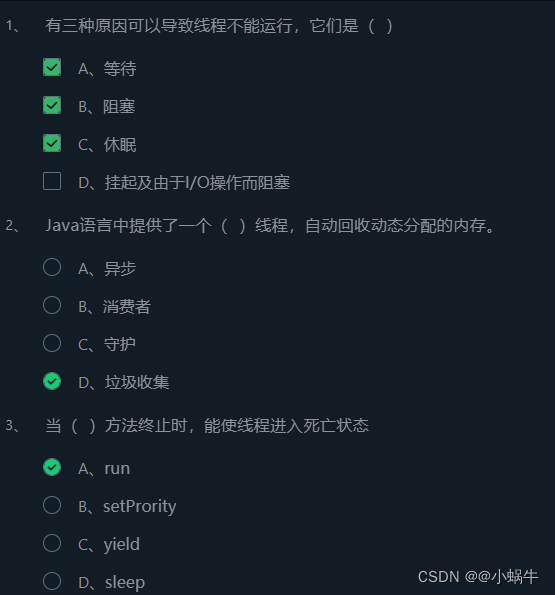
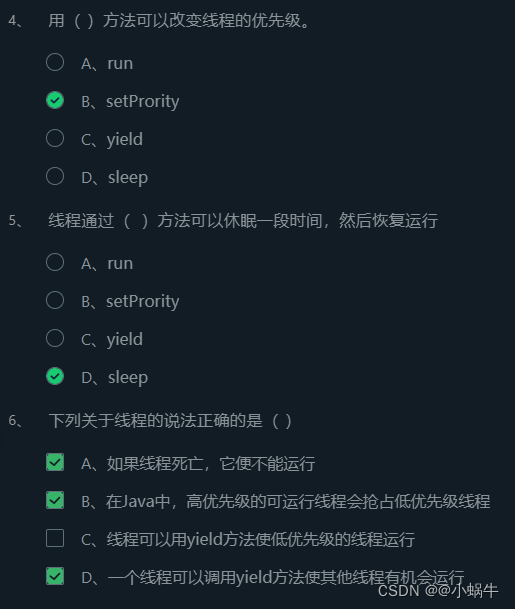
第2关:常用函数(sleep/join)
package step2;
import java.util.*;
import java.util.Scanner;
public class Task {
public static void main(String[] args) {
Scanner sc = new Scanner(System.in);
int num = sc.nextInt();
//请在此添加实现代码
/********** Begin **********/
/**创建自定义线程,实现求第num项斐波那契数列的值num从0开始,
并且在main函数中获取子线程最终计算的结果。*/
/********** End **********/
Thread t = new MyThread(num);
t.start();
try {
t.join();
} catch (Exception e) {
e.printStackTrace();
}
// System.out.println("主线程结束");
}
}
//请在此添加实现代码
/********** Begin **********/
/**创建自定义线程,实现求第num项斐波那契数列的值num从0开始*/
class MyThread extends Thread {
private int num;
public MyThread(int num) {
this.num = num;
}
public void run() {
// System.out.println("子线程开始运行");
int a1=1;
int a2=1;
int a3=0;
for (int i = 3; i <=num;i++) {
a3=a2+a1;//2.根据前两个数算出第三个数
a1=a2;//3.更新第一第二个数
a2=a3;
}
System.out.println("子线程计算结果为:" + a3);
try {
Thread.sleep(30);
} catch (InterruptedException e) {
e.printStackTrace();
}
//System.out.println("子线程结束");
}
}
/********** End **********/
第3关:常用函数(wait/yield)
package step3;
//建立三个线程,A线程打印5次E,B线程打印5次D,C线程打印5次U,要求线程同时运行,交替打印5次EDU。
public class MyThread implements Runnable {
//请在此添加实现代码
private String name;
private Object prev;
private Object self;
private MyThread(String name, Object prev,Object self) {
this.name = name;
this.prev = prev;
this.self = self;
}
public void run() {
int count = 5;
while (count > 0) {
synchronized (prev) {
synchronized (self) {
System.out.print(name);
count--;
self.notify();
}
try {
prev.wait();
} catch (InterruptedException e) {
e.printStackTrace();
}
}
}
System.exit(0);//退出jvm
}
/********** Begin **********/
public static void main(String[] args) throws Exception {
Object a = new Object();
Object b = new Object();
Object c = new Object();
MyThread ta = new MyThread("E", c,a);
MyThread tb = new MyThread("D", a,b);
MyThread tc = new MyThread("U", b,c);
new Thread(ta).start();
Thread.sleep(100); //确保按顺序A、B执行
new Thread(tb).start();
Thread.sleep(100);
new Thread(tc).start();
Thread.sleep(100);
}
/********** End **********/
}
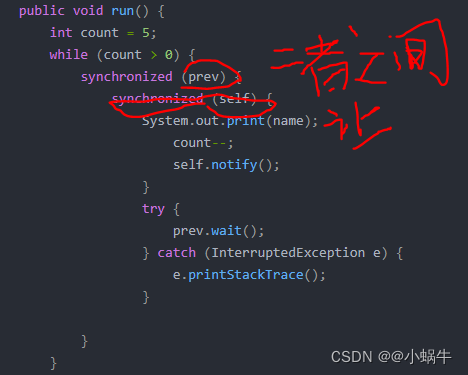
3-6Java高级特性 - 多线程基础(3)线程同步
Java内存模型只保证了基本读取和赋值是原子性操作,如果要实现大范围的原子性,可以通过synchronized和lock来实现,lock(锁)和synchronized(同步)在后面的关卡会介绍。
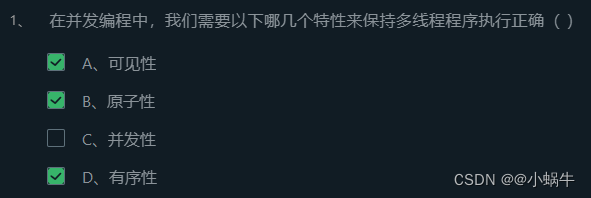
第2关:使用synchronized关键字同步线程
在Java中,每一个对象都有一个锁标记(monitor),也被称为监视器,当多个线程访问对象时,只有获取了对象的锁才能访问。
当某个线程访问这个对象synchronized方法或者代码块时,就获取到了这个对象的锁,
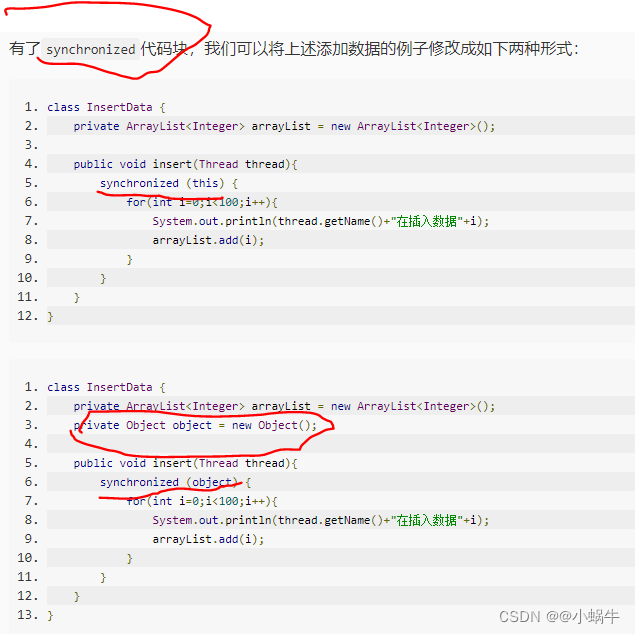
第3关:使用线程锁(Lock)实现线程同步
Lock不是Java语言内置的,而是一个类。
使用Lock必须在try{}catch{}块中进行,并且将释放锁的操作放在finally块中进行,以保证锁一定被被释放,防止死锁的发生。
Lock lock = ...;
if(lock.tryLock()) {
try{
//处理任务
}catch(Exception ex){
}finally{
lock.unlock(); //释放锁
}
}else {
//如果不能获取锁,则直接做其他事情
}
tryLock()顾名思义,是用来尝试获取锁的,并且该方法有返回值,表示获取成功与否,获取成功返回true,失败返回false,从方法可以发现,该方法如果没有获取到锁时不会继续等待的,而是会直接返回值。
lock()实现同步呢?相信你已经想到了,只要将Lock定义成全局变量
package step3;
import java.util.concurrent.TimeUnit;
import java.util.concurrent.locks.Lock;
import java.util.concurrent.locks.ReentrantLock;
public class Task {
public static void main(String[] args) {
final Insert insert = new Insert();
Thread t1 = new Thread(new Runnable() {
public void run() {
insert.insert(Thread.currentThread());
}
});
Thread t2 = new Thread(new Runnable() {
public void run() {
insert.insert(Thread.currentThread());
}
});
Thread t3 = new Thread(new Runnable() {
public void run() {
insert.insert(Thread.currentThread());
}
});
// 设置线程优先级
t1.setPriority(Thread.MAX_PRIORITY);
t2.setPriority(Thread.NORM_PRIORITY);
t3.setPriority(Thread.MIN_PRIORITY);
t1.start();
t2.start();
t3.start();
}
}
class Insert {
public static int num;
// 在这里定义Lock
private Lock lock = new ReentrantLock();
public void insert(Thread thread) {
/********* Begin *********/
lock.lock();
try{
System.out.println(thread.getName()+"得到了锁");
for (int i = 0; i < 5; i++) {
num++;
System.out.println(num);
}
}catch (Exception e){
}finally{
System.out.println(thread.getName()+"释放了锁");
lock.unlock();
}
/********* End *********/
}
}
第4关:使用volatile实现变量的可见性
volatile是干啥用的,有什么含义和特点呢?
当一个共享变量被volatile修饰时,它就具备了“可见性”,即这个变量被一个线程修改时,
这个改变会立即被其他线程知道。
当一个共享变量被volatile修饰时,会禁止“指令重排序”。
中断线程一般都会采用下面代码
//线程1
boolean stop = false;
while(!stop){
doSomething();
}
//线程2
stop = true;
3-7Java高级特性 - 多线程练习题
顺序输出
package step1;
public class Task {
public static void main(String[] args) throws Exception {
/********* Begin *********/
//在这里创建线程, 开启线程
Object a = new Object();
Object b = new Object();
Object c = new Object();
MyThread ta = new MyThread("A",c,a);
MyThread tb = new MyThread("B",a,b);
MyThread tc = new MyThread("C",b,c);
ta.start();
ta.sleep(100);
tb.start();
tb.sleep(100);
tc.start();
tc.sleep(100);
/********* End *********/
}
}
class MyThread extends Thread {
/********* Begin *********/
private String threadName;
private Object prev;
private Object self;
public MyThread(String name,Object prev,Object self){
this.threadName = name;
this.prev = prev;
this.self = self;
}
public void run() {
int count = 5;
while(count>0){
synchronized(prev){
synchronized(self){
System.out.println("Java Thread"+this.threadName+this.threadName);
count--;
self.notify();
}
try {
prev.wait();
} catch (InterruptedException e) {
e.printStackTrace();
}
}
}
System.exit(0);
}
/********* End *********/
}
售票问题
package step2;
/********* Begin *********/
import java.util.concurrent.locks.ReentrantLock;
//定义站台类,实现卖票的功能。
public class Station extends Thread {
private static ReentrantLock lock = new ReentrantLock();
private static int ticket = 20;
@Override
public void run() {
while (true) {
try {
lock.lock();
if (ticket > 0) {
try {
Thread.sleep(10);
} catch (InterruptedException e1) {
// TODO 自动生成的 catch 块
e1.printStackTrace();
}
System.out.println("卖出了第" + ticket + "张票");
ticket--;
} else {
System.out.println("票卖完了");
System.exit(0);
}
} finally {
lock.unlock();
}
}
}
}
/********* End *********/
3-8Java高级特性 - Java反射’
三种获取Class类型的实例的方法;
通过Object类中的getClass()方法;
通过静态方法Class.forName(“全类名”);
通过类字面常量Class.class。
第1关:了解 Class 对象
package step1;
/**
* 学员任务文件
*/
public class Reflect_stu {
public static void main(String[] args) {
System.out.println("通过Object 类中的 getClass() 获取的 Class 对象为:" + getPersonClass1());
System.out.println("通过静态方法 Class.forName() 获取的 Class 对象为:" + getPersonClass2());
System.out.println("通过类字面常量获取 Class 的对象为:" + getPersonClass3());
}
/**
* 通过 Object 类中的 getClass() 获取的 Class 对象
*
* @return
*/
public static Class getPersonClass1() {
/********** Begin *********/
return new Person().getClass();
/********** End *********/
}
/**
* 通过静态方法 Class.forName() 获取的 Class 对象
* <p>
* 注意:Person 类的全路径为: step1.Person
*
* @return
*/
public static Class getPersonClass2() {
/********** Begin *********/
Class clazz = null;
String className = "step1.Person";
try {
clazz = Class.forName(className);
} catch(ClassNotFoundException e) {
}
return clazz;
/********** End *********/
}
/**
* 通过类字面常量获取 Class 的对象
*
* @return
*/
public static Class getPersonClass3() {
/********** Begin *********/
return Person.class;
/********** End *********/
}
}
第2关:利用反射分析类的能力
反射的基本概念
反射就是在运行时才知道要操作的类是什么,并且可以在运行时获取类的完整构造,并调用对应的方法。
提示:
Method.getReturnType()可以获得方法的返回类型。
打印方法或域的修饰符可以调用提供的printModifiers()方法
打印方法的参数可以调用提供的printParamTypes()方法
Field的getType方法可以获得域类型、getName方法可以获得域的名称
java.lang.reflect包中有三个类Field、Method和Constructor分别用于描述类的域、方法和构造器。
Class类中的getFields()、getMethods()和getConstructors()方法将分别返回类提供的 public 域、方法和构造器,其中包括超类的共有成员。
Class类中的getDeclareFields()、getDeclareMethods()和getDeclareConstructors()方法将分别返回类中声明的全部域、方法和构造器,其中包括私有和受保护的成员,但不包括超类的成员。
package step2;
import java.lang.reflect.Constructor;
import java.lang.reflect.Field;
import java.lang.reflect.Method;
import java.lang.reflect.Modifier;
class Apple {
private String name;
public Apple(){}
public Apple(String name){}
public void setName(String name) {
this.name = name;
}
}
public class Reflect_stu {
public static void main(String[] args) {
// 请根据提供的 classPath 获取 step2.Apple 的 Class 对象, 请使用 Class.forName() 方法, 注意捕获异常
// 通关之后,你也可以修改 clasapath 为其他类路径,分析某个类的能力, 例如: java.util.Date
String classPath = "step2.Apple";
Class clazz = null;
/********** Begin *********/
try {
clazz = Class.forName(classPath);
} catch (ClassNotFoundException e) {
e.printStackTrace();
}
/********** End *********/
printFields(clazz);
printConstructors(clazz);
printMethods(clazz);
}
/**
* 请打印类的每个域,输出格式为:修饰符 类型 变量名;
* @param clazz
*/
public static void printFields(Class clazz) {
/********** Begin *********/
Field[] fields = clazz.getDeclaredFields();
for (Field field : fields) {
// 获得描述域所属类型的Class对象
Class type = field.getType();
//获得域的名字
String name = field.getName();
// 获得域的描述符
String modifiers = Modifier.toString(field.getModifiers());
if (modifiers.length() > 0) {
System.out.print(modifiers + " ");
}
System.out.println(type.getName() + " " + name + ";");
}
/********** End *********/
}
/**
* 打印构造函数,输出格式为:修饰符 方法名称(参数)
* @param clazz
*/
public static void printConstructors(Class clazz) {
Constructor[] constructors = clazz.getDeclaredConstructors();
for (Constructor constructor : constructors) {
Class[] paramTypes = null;
/********** Begin *********/
String name = constructor.getName();
String modifiers = Modifier.toString(constructor.getModifiers());
if (modifiers.length() > 0) {
System.out.print(modifiers + " ");
}
System.out.print(name + "(");
paramTypes = constructor.getParameterTypes();
/********** End *********/
printParamTypes(paramTypes);
}
}
/**
* 请针对每个方法打印其签名,格式为:修饰符 返回值类型 方法名称(参数);
* @param clazz
*/
public static void printMethods(Class clazz) {
Method[] methos = clazz.getDeclaredMethods();
for (Method method : methos) {
Class[] paramTypes = null;
/********** Begin *********/
Class returnType = method.getReturnType();
String name = method.getName();
String modifiers = Modifier.toString(method.getModifiers());
if (modifiers.length() > 0) {
System.out.print(modifiers + " ");
}
System.out.print(returnType.getName() + " " + name + "(");
//Class[] paramTypes = method.getParameterTypes();
paramTypes = method.getParameterTypes();
/********** End *********/
printParamTypes(paramTypes);
}
}
/**
* 打印方法参数
* @param paramTypes
*/
private static void printParamTypes(Class[] paramTypes) {
for (int j = 0; j < paramTypes.length; ++j) {
if (j > 0) {
System.out.print(",");
}
System.out.print(paramTypes[j].getName());
}
System.out.println(");");
}
}
第3关:在运行时使用反射分析对象
如何通过 Field 类的 get 方法获取对象域
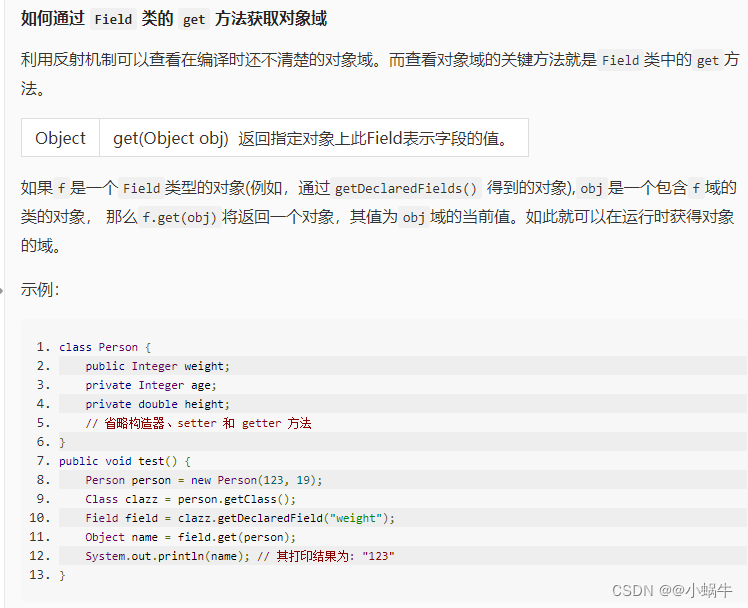
package step3;
import java.lang.reflect.AccessibleObject;
import java.lang.reflect.Field;
import java.lang.reflect.Modifier;
public class Reflect_stu {
public static String toString(Object obj) {
Class cl = obj.getClass();
String r = "";
r += "[";
// 请获取所有 Field 并设置访问权限为 true
/********** Begin *********/
Field[] fields = null;
fields=cl.getDeclaredFields();
AccessibleObject.setAccessible(fields, true);
/********** End *********/
for (Field f : fields) {
// 此处 if,逻辑为判断 Field 域是否为非静态域
if (!Modifier.isStatic(f.getModifiers())) {
if (!r.endsWith("[")) r += ",";
r += f.getName() + "=";
try {
// 请获取域的类型及值
/********** Begin *********/
Class t = null;
Object val = null;
t =f.getType();
val = f.get(obj);
/********** End *********/
// isPrimitive() 用于判断是否为基本数据类型,若为基础数据类型直接拼接,否则递归调用 toString 方法
if (t.isPrimitive()) r += val;
else r += toString(val);
} catch (Exception e) {
e.printStackTrace();
}
}
}
r += "]";
return r;
}
public static void main(String[] args) {
Person person = new Person(88, 19, 175);
System.out.println(toString(person));
}
}
class Person {
public Integer weight;
private Integer age;
private Double height;
public Person(Integer weight, Integer age, double height) {
this.weight = weight;
this.age = age;
this.height = height;
}
}
第4关:利用反射进行方法调用
通过反射创建对象
通过Class对象的newInstance()方法
第一种:通过Class对象的newInstance()方法。
Class clazz = Apple.class;
Apple apple = (Apple)clazz.newInstance();
通过Constructor对象的 newInstance()方法
第二种:通过Constructor对象的newInstance()方法
Class clazz = Apple.class;
Constructor constructor = clazz.getConstructor();
Apple apple = (Apple)constructor.newInstance();
如何通过反射调用对象方法
// 获取类的 Class 对象实例
Class clz = Class.forName("Apple");
// 根据 Class 对象实例获取 Constructor 对象
Constructor appleConstructor = clz.getConstructor();
// 使用 Constructor 对象的 newInstance 方法获取反射类对象
Object appleObj = appleConstructor.newInstance();
// 而如果要调用某一个方法,则需要经过下面的步骤:
// 1、获取方法的 Method 对象
Method setPriceMethod = clz.getMethod("setPrice", int.class);
// 2、用 invoke 方法调用方法
setPriceMethod.invoke(appleObj, 14);
class Apple {
public void setPrice(int price) {
//省略
}
// 省略
}
package step4;
import java.lang.reflect.Constructor;
import java.lang.reflect.InvocationTargetException;
import java.lang.reflect.Method;
/**使用反射调用 Apple 类的 setPrice()方法,设置苹果价格为 14,并打印价格。接着还要用反射去调用getTotal方法获取单价为 20,数量 24 的总金额并打印。*/
public class Reflect_stu {
public static void main(String[] args) throws InvocationTargetException {
//使用反射调用
Class clazz = null;
try {
// 获取类的 Class 对象实例
clazz = Class.forName("step4.Apple");
/********** Begin *********/
// 获取方法的 Method 对象
Method setPriceMethod = clazz.getMethod("setPrice", double.class);
// 根据 Class 对象实例获取 Constructor 对象
Constructor appleConstructor = clazz.getConstructor();
// 使用 Constructor 对象的 newInstance 方法获取反射类对象
Object apple = appleConstructor.newInstance();
//用 invoke 方法调用方法
setPriceMethod.invoke(apple, 14);
Method getPriceMethod = clazz.getMethod("getPrice");
System.out.println(getPriceMethod.invoke(apple));
Method getTotal = clazz.getMethod("getTotal", double.class, int.class);
System.out.println(getTotal.invoke(apple, 20, 24));
/********** End *********/
} catch (Exception e) {
e.printStackTrace();
}
}
}
class Apple {
private double price;
private int count;
public Apple() {
}
public double getPrice() {
return price;
}
public void setPrice(double price) {
this.price = price;
}
public int getCount() {
return count;
}
public void setCount(int count) {
this.count = count;
}
public double getTotal(double price, int count) {
return price * count;
}
}
3-9Java高级特性 - JDBC(上)
JDBC(Java DataBase Connectivity)是一种用于执行SQL语句的Java API,它由一组用Java语言编写的类和接口组成。换句话说:就是可以直接通过java语言,去操作数据库。
JDBC库包括常与数据库使用相关的API:
连接数据库;
创建SQL或MySQL语句;
在数据库中执行SQL或MySQL查询;
查看和修改结果记录。
第1关JDBC连接数据库
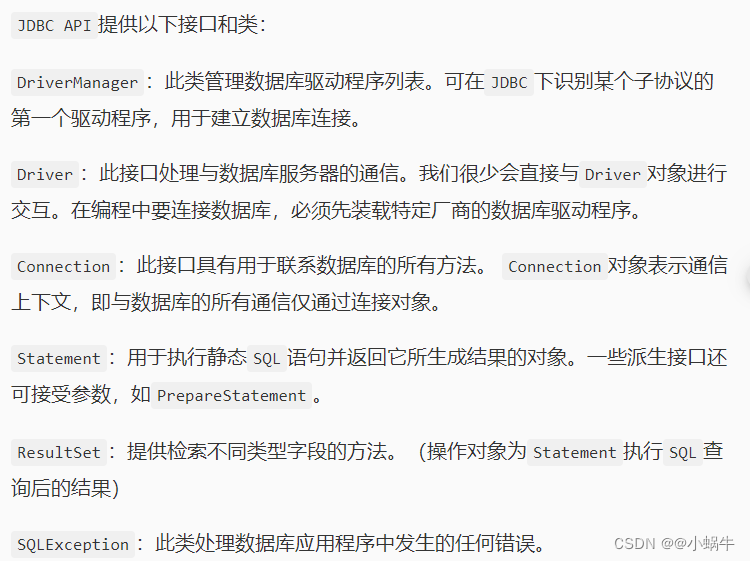

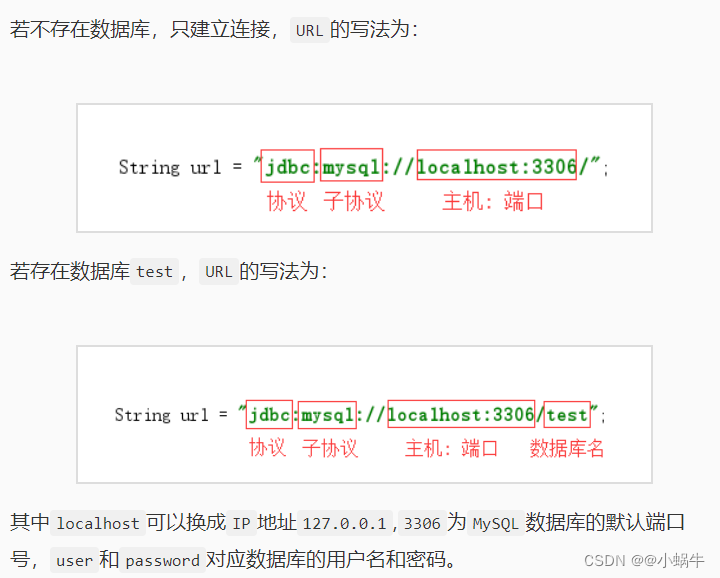
package jdbc;
import java.sql.*;
public class jdbcConn {
public static void getConn() {
/********** Begin **********/
try {
//1.注册驱动
Class.forName("com.mysql.jdbc.Driver" );
} catch (ClassNotFoundException e) {
e.printStackTrace();
}
/********** End **********/
/********** Begin **********/
Connection conn = null;
Statement statement = null;
//2.建立连接并创建数据库和表
//建立数据库连接(Connection)一定要抛出异常
try{
String url = "jdbc:mysql://localhost:3306";
conn = DriverManager.getConnection(url,"root","123123");
}catch(SQLException e){
e.printStackTrace();
}
// 创建执行SQL语句的Statement对象
try {
statement = conn.createStatement();
} catch (SQLException e) {
e.printStackTrace();
}
//创建数据库
try {
String sql1="drop database if exists mysql_db";
String sql2="create database mysql_db";
statement.executeUpdate(sql1);//执行sql语句
statement.executeUpdate(sql2);
} catch (SQLException e) {
e.printStackTrace();
}
//创建表
try {
statement.executeUpdate("use mysql_db");//选择在哪个数据库中操作
String sql = "create table student(" +
"id int not null, " +
"name varchar(20)," +
"sex varchar(4),"+
"age int "+
")";
statement.executeUpdate(sql);
} catch (SQLException e) {
e.printStackTrace();
}
/********** End **********/
//为确保资源释放代码能运行,资源释放代码一定要放在finally语句中。
finally {
try {
if(statement!=null)
statement.close();
if(conn!=null)
conn.close();
} catch (SQLException e) {
e.printStackTrace();
}
}
}
}
第2关JDBC对表中数据的操作
package jdbc;
import java.sql.*;
import java.util.ArrayList;
import java.util.List;
public class jdbcInsert {
public static void insert(){
/********** Begin **********/
try {
//加载驱动
Class.forName("com.mysql.jdbc.Driver" );
} catch (ClassNotFoundException e) {
e.printStackTrace();
}
/********** End **********/
Connection conn = null;
PreparedStatement statement = null;
/********** Begin **********/
//连接并插入数据
try{
String url = "jdbc:mysql://localhost:3306/mysql_db";
conn = DriverManager.getConnection (url,"root","123123");
statement = conn.prepareStatement("insert into student(id,name,sex,age) values(?,?,?,?)");//使用占位符来先占个位置
statement.setInt(1,1);
statement.setString(2, "张三");
statement.setString(3,"男");
statement.setInt(4, 19);
statement.executeUpdate();//每执行一个sql语句就需要执行该方法
statement.setInt(1,2);
statement.setString(2, "李四");
statement.setString(3,"女");
statement.setInt(4, 18);
statement.executeUpdate();
statement.setInt(1,3);
statement.setString(2, "王五");
statement.setString(3,"男");
statement.setInt(4, 20);
statement.executeUpdate();
PreparedStatement statement1 = conn.prepareStatement("select * from student");
ResultSet r = statement1.executeQuery();//将执行结果给ResultSet
while (r.next()) {//循环判断表中是否还有数据
System.out.println(r.getString(1)+" "+r.getString(2)+" "+
r.getString(3)+" "+r.getString(4));//通过列的索引查询
//一行数据
}
} catch (SQLException e) {
e.printStackTrace();
}
/********** End **********/
finally {
try {
if (statement != null)
statement.close();
if (conn != null)
conn.close();
} catch (SQLException e) {
e.printStackTrace();
}
}
}
}
第3关JDBC事务
package jdbc;
import java.sql.*;
public class jdbcTransaction {
public static void transaction(){
try {
Class.forName("com.mysql.jdbc.Driver" );
} catch (ClassNotFoundException e) {
e.printStackTrace();
}
Connection conn = null;
PreparedStatement ps = null;
/********** Begin **********/
//连接数据库并开启事务
try {
String url = "jdbc:mysql://localhost:3306/mysql_db";
conn = DriverManager.getConnection (url,"root","123123" );
conn.setAutoCommit(false);//关闭自动提交开启事务
ps = conn.prepareStatement("insert into student(id,name,sex,age) values(?,?,?,?)");
ps.setInt(1,4);
ps.setString(2, "赵六");
ps.setString(3,"女");
ps.setInt(4, 21);
ps.executeUpdate();
conn.commit();//提交事务
} catch (SQLException e) {
try {
//事务回滚
conn.rollback();//回滚事务 回滚到你开始事务之前
} catch (SQLException e1) {
e1.printStackTrace();
}
}
/********** End **********/
finally {
try {
if(ps!=null)
ps.close();
if (conn != null)
conn.close();
} catch (SQLException e1) {
e1.printStackTrace();
}
}
}
}
3-10Java高级特性 - JDBC(下)
第1关指定类型JDBC封装
package step1;
import java.sql.Connection;
import java.sql.DriverManager;
import java.sql.PreparedStatement;
import java.sql.ResultSet;
import java.sql.SQLException;
import java.util.ArrayList;
import java.util.List;
import test.News;
public class JDBCUtils {
/**
* 连接数据库
*/
private static Connection getConnection() {
Connection conn=null;
/********** Begin **********/
String url="jdbc:mysql://localhost:3306/mysql_db";
try {
//注册驱动
Class.forName("com.mysql.jdbc.Driver");
conn = DriverManager.getConnection (url,"root","123123");
}catch (ClassNotFoundException e) {
e.printStackTrace();
}catch (SQLException e) {
e.printStackTrace();
}
/********** End **********/
return conn;
}
/**
* 更新数据方法
* @param news
* @throws SQLException
*/
public void update(News news) throws SQLException {
Connection conn = getConnection();
PreparedStatement ps = null;
/********** Begin **********/
String sql = "update news set title = ? ,author_name = ? where id = ?";
try{
ps = conn.prepareStatement(sql);
ps.setObject(1, news.getTitle());
ps.setObject(2, news.getAuthor_name());
ps.setObject(3, news.getId());
ps.execute();
}catch(SQLException e){
e.printStackTrace();
throw new SQLException("更新数据失败");
}finally{
close(null, ps, conn);
}
/********** End **********/
}
/**
* 查询所有数据
* @return
* @throws SQLException
*/
public List<News> findAll() throws SQLException {
Connection conn = getConnection();
PreparedStatement ps = null;
ResultSet rs = null;
News news = null;
List<News> newsList = new ArrayList<News>();
/********** Begin **********/
String sql = "select * from news";
try {
ps = conn.prepareStatement(sql);
rs = ps.executeQuery();//将执行结果给ResultSet
while (rs.next()) {
news = new News(rs.getInt(1), rs.getString(2), rs.getString(3));
newsList.add(news);
}
}catch(SQLException e){
e.printStackTrace();
throw new SQLException("查询所有数据失败");
}finally{
close(rs, ps, conn);
}
/********** End **********/
return newsList;
}
/**
* 删除方法
* @param id
* @throws SQLException
*/
public void delete(int id) throws SQLException{
Connection conn = getConnection();
PreparedStatement ps = null;
/********** Begin **********/
String sql = "delete from news where id=?";
try {
ps = conn.prepareStatement(sql);
ps.setObject(1, id);
ps.execute();
}catch(SQLException e){
e.printStackTrace();
throw new SQLException(" 删除数据失败");
}
finally{
close(null, ps, conn);
}
/********** End **********/
}
/**
* 增加对象
* @param news
* @throws SQLException
*/
public void insert(News news) throws SQLException {
Connection conn = getConnection();
PreparedStatement ps = null;
String sql = "insert into news(id,title,author_name)values(?,?,?)";
try{
ps = conn.prepareStatement(sql);
ps.setInt(1, news.getId());
ps.setString(2, news.getTitle());
ps.setString(3, news.getAuthor_name());
ps.executeUpdate();
}catch(SQLException e){
e.printStackTrace();
throw new SQLException("添加数据失败");
}finally{
close(null, ps, conn);
}
}
/**
* 根据id查询对象
* @param id
* @return
* @throws SQLException
*/
public News findById(int id) throws SQLException {
Connection conn = getConnection();
PreparedStatement ps = null;
ResultSet rs = null;
News news = null;
String sql = "select * from news where id=?";
try{
ps = conn.prepareStatement(sql);
ps.setInt(1, id);
rs = ps.executeQuery();
if(rs.next()){
news = new News();
news.setId(id);
news.setTitle(rs.getString(2));
news.setAuthor_name(rs.getString(3));
}
}catch(SQLException e){
e.printStackTrace();
throw new SQLException("根据ID查询数据失败");
}
finally{
close(rs, ps, conn);
}
return news;
}
/**
* 关闭数据库连接
* @param rs
* @param ps
* @param conn
*/
public static void close(ResultSet rs,PreparedStatement ps,Connection conn){
try {
if(rs!=null)rs.close();
if(ps!=null)ps.close();
if(conn!=null)conn.close();
} catch (SQLException e) {
e.printStackTrace();
}
}
}
第2关泛型JDBC封装
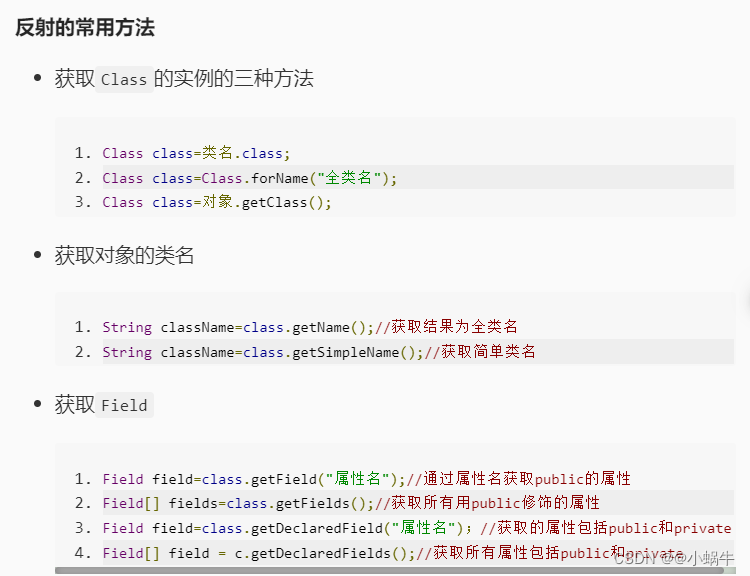
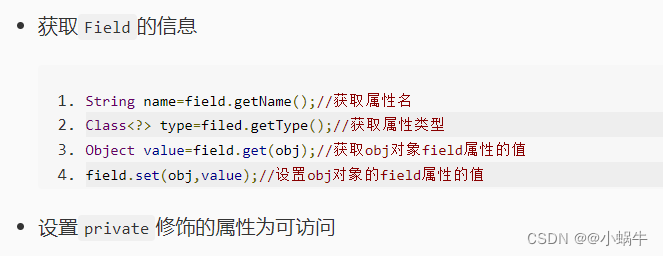
3-11JDBC基础编程练习
第1关JDBC更新员工密码
package step1;
import java.sql.*;
public class UpdatePass {
// 修改数据
public static void updateDB() {
/********* Begin *********/
// 第一步:加载驱动
try {
//1.注册驱动
Class.forName("com.mysql.jdbc.Driver" );
} catch (ClassNotFoundException e) {
e.printStackTrace();
}
// 第二步:建立连接, "root"和"123123"是针对MySQL设置了用户名(root)和密码(123123)的情况
Connection conn = null;
Statement statement = null;
// 127.0.0.1:3306是mysql服务器地址及端口 数据库编码格式设置为utf-8
try{
String url="jdbc:mysql://127.0.0.1:3306";
conn = DriverManager.getConnection(url,"root","123123");
}catch(SQLException e){
e.printStackTrace();
}
// 第三步:建立statement对象
try{
statement = conn.createStatement();
}catch(SQLException e){
e.printStackTrace();
}
// 第四步:修改数据
try{
statement.executeUpdate("use tsgc");
String sql1="update employee set password='hello' where sex='女'";
statement.executeUpdate(sql1);
}catch(SQLException e){
e.printStackTrace();
}
// 第五步:关闭statement对象和连接对象
finally {
try {
if(statement!=null)
statement.close();
if(conn!=null)
conn.close();
} catch (SQLException e) {
e.printStackTrace();
}
}
/********* End *********/
}
}
第2关JDBC查询员工信息
package step1;
import java.sql.*;
public class QueryPass {
// 查询数据代码不用上实验报告
public static void queryDB() {
/********* Begin *********/
// 第一步:加载驱动
try {
//1.注册驱动
Class.forName("com.mysql.jdbc.Driver" );
} catch (ClassNotFoundException e) {
e.printStackTrace();
}
// 第二步:建立连接, "root"和"123123"是针对MySQL设置了用户名(root)和密码(123123)的情况
// 127.0.0.1:3306是mysql服务器地址及端口 数据库编码格式设置为utf-8
Connection conn=null;
Statement statement=null;
try{
String url="jdbc:mysql://127.0.0.1:3306";
conn = DriverManager.getConnection(url,"root","123123");
}catch(SQLException e){
e.printStackTrace();
}
// 第三步:建立statement对象
try{
statement = conn.createStatement();
}catch(SQLException e){
e.printStackTrace();
}
// 第四步:查询数据
try{
statement.executeUpdate("use tsgc");
PreparedStatement statement1 = conn.prepareStatement("select * from employee");
ResultSet r = statement1.executeQuery();//将执行结果给ResultSet
while (r.next()) {//循环判断表中是否还有数据
System.out.println("no:"+r.getString(1)+" "
+"name:"+r.getString(2)+" "
+"password:"+r.getString(3)+" "
+"sex:"+r.getString(4)+" "
+"salary:"+r.getFloat(5));//通过列的索引查询
//一行数据
}
}catch(SQLException e){
e.printStackTrace();
}
// 第五步:关闭statement对象和连接对象
finally {
try {
if (statement != null)
statement.close();
if (conn != null)
conn.close();
} catch (SQLException e) {
e.printStackTrace();
}
}
/********* End *********/
}
}






















 3万+
3万+

 被折叠的 条评论
为什么被折叠?
被折叠的 条评论
为什么被折叠?








